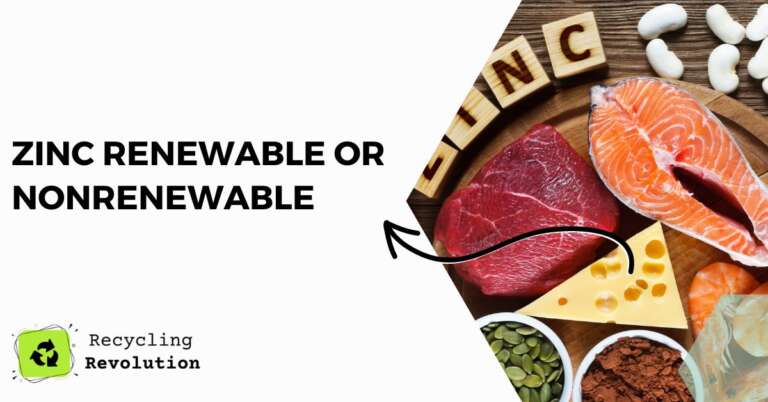Oh, zinc! You may have first encountered it in your periodic table during high school, or perhaps in those supplements that promise to boost your immune system. But the question on everyone’s mind is.
tl;dr: Zinc is a nonrenewable resource, which means once we deplete the available reserves, it can’t regenerate in human timescales. However, with recycling and sustainable mining, we can extend its availability for future generations.
Zinc is an essential trace mineral that’s paramount not only for the human body but also in numerous industries such as construction, automobile, cosmetics, and more. It is the 24th most abundant element in the Earth’s crust, making it relatively common.
Note: The word “abundant” doesn’t mean infinite. It’s essential to differentiate between the two, especially when discussing the sustainability of a resource.
Nonrenewable? Why is that?
When we speak of resources being renewable or nonrenewable, we’re diving into how quickly these resources can regenerate (if at all) compared to how fast we humans consume them. Renewable resources, like the wind or sunlight, are naturally replenished. On the other hand, nonrenewable resources like minerals and fossil fuels take millions of years to form.
Zinc falls into the latter category. It’s formed through various geological processes over millions of years. In contrast, human consumption and the rate at which we extract zinc are merely in decades. Thus, in the context of human timescales, zinc is nonrenewable.
The Reality of Zinc Mining and Consumption
According to studies from the U.S. Geological Survey, while there’s still a significant amount of zinc in underground reserves globally, the rate at which we’re mining and consuming it suggests that we need to be more cautious about its future availability.
The good news? We’ve been getting better at recycling zinc. Nearly 30% of the zinc used worldwide is from recycled or secondary zinc. And this is where I find a glimmer of hope. While we cannot regenerate zinc deposits, I recommend fostering a culture of recycling to ensure that the zinc we’ve already extracted continues to be in circulation.
Sustainability and The Future of Zinc
Even though zinc is nonrenewable, that doesn’t mean we can’t use it sustainably. The key is to strike a balance between consumption, recycling, and responsible mining.
- Recycling: As mentioned earlier, a significant chunk of the zinc used globally comes from recycling. Encouraging more industries to adopt zinc recycling practices can be a game-changer.
- Innovative Mining Techniques: Reducing the environmental footprint of zinc mining by adopting sustainable extraction techniques can make a difference. For instance, some companies are exploring methods that use less water or generate fewer greenhouse gases.
- Reduction in Consumption: Wherever possible, industries can look at alternatives or reduce the use of zinc.
Zinc’s Multifaceted Role in Our Lives
One of the marvels of zinc lies in its versatile applications. From healthcare to construction, this element weaves its magic in many forms.
Zinc in Medicine and Nutrition
Our bodies require zinc for numerous processes. From aiding in DNA synthesis to playing a crucial role in our immune responses, zinc is a staple in our biological systems. Moreover, it’s a key ingredient in various over-the-counter medications, especially those targeting colds and immune support. This is a testament to its critical role in human health.
Note: It’s always recommended to consume zinc within the advised limits. Excess zinc can lead to health issues such as nausea, vomiting, and even lowering of “good” HDL cholesterol.
Zinc in Industry
Zinc’s anti-corrosive properties make it invaluable in industries. One of the primary uses of zinc is in galvanizing, a process where a protective zinc coating is applied to steel or iron to prevent rusting. This treatment extends the life of metals, making them a sustainable choice for construction and automotive industries.
Beyond galvanizing, zinc finds its place in alloys like brass and bronze. Its ability to bond with other metals and enhance their properties makes it indispensable in many sectors.
The Environmental Impact of Zinc Mining
While discussing zinc’s nonrenewability, it’s also vital to touch upon the environmental effects of its extraction. Mining, in general, is associated with significant land, water, and air degradation, and zinc mining is no exception.
Land and Habitat Destruction
Zinc mining can lead to the removal of large areas of land, affecting local ecosystems and wildlife habitats. The displacement of soil layers can result in the loss of fertile topsoil, making land reclamation post-mining a challenge.
Water Pollution
Water bodies near mining sites can get contaminated due to the runoff from the mines. Toxic substances used in, or generated by, the mining process can seep into the groundwater or flow into nearby rivers and streams.
This can significantly affect marine life and the quality of drinking water in surrounding areas.
Air Pollution
The process of zinc extraction and refining can release greenhouse gases and other pollutants into the air. Sulphur dioxide, for instance, is a common byproduct of zinc smelting, contributing to acid rain.
Efforts in Making Zinc Mining Sustainable
Despite the challenges, many initiatives are focusing on sustainable zinc mining.
Adopting Cleaner Technologies
Modern technologies aim to reduce the environmental footprint of zinc extraction. This includes methods that minimize water usage, decrease energy consumption, and reduce emissions.
By transitioning to these technologies, the industry can mitigate some of the environmental impacts associated with traditional mining.
Rehabilitation of Mining Sites
An approach that is gaining traction is the rehabilitation of mined areas. Once a mining operation concludes, efforts are made to restore the site to its natural state or repurpose it for other productive uses.
Community Engagement and Rights
Sustainable mining is not just about the environment. It’s also about the people who live in mining regions.
Engaging local communities, respecting indigenous rights, and ensuring that mining brings tangible benefits to the local populace are essential aspects of sustainable mining.
The Road to Recycling
We’ve touched upon this before, but it’s worth reiterating the importance of recycling in the context of nonrenewable resources. Recycled zinc, often termed ‘secondary zinc,’ is no less in quality than its freshly mined counterpart.
Moreover, the process of recycling zinc is often less energy-intensive than mining new zinc, leading to a reduced carbon footprint.
I recommend always opting for products made from recycled materials whenever possible. This not only supports the recycling industry but also reduces the demand for newly extracted zinc.
Consumer Role in Zinc Sustainability
As consumers, we wield more power than we often realize. By making informed choices, demanding transparency from companies about their sourcing practices, and advocating for sustainable extraction methods, we can drive change in the industry.
In essence, while the inherent nature of zinc classifies it as nonrenewable, the actions we take today can shape the future of its sustainability. From recycling to responsible consumption, each step can make a difference.
Conclusion
To wrap things up, zinc is undeniably a nonrenewable resource. It’s a finite mineral that doesn’t regenerate quickly enough for human consumption rates.
However, with the combined powers of recycling, innovative mining, and mindful consumption, we can ensure that zinc remains available for many generations to come.
FAQ
Is zinc running out?
While zinc is plentiful, it’s not infinite. With current consumption rates and mining practices, we may face challenges in the future. However, as of now, there’s no immediate shortage.
How can I contribute to zinc sustainability?
Recycling products containing zinc, supporting sustainable brands, and promoting awareness about the importance of recycling can be significant steps.
Are there alternatives to zinc in industries?
In some industries, there are alternatives to zinc. However, due to zinc’s unique properties, it remains irreplaceable in many applications.
Remember, every bit counts when it comes to conserving our planet’s resources. Even though we’re talking about zinc today, the same principles apply to all nonrenewable resources. Let’s cherish and respect what we have!

